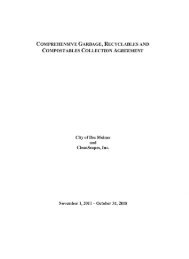CITY OF DES MOINES SHORELINE MASTER PROGRAM
CITY OF DES MOINES SHORELINE MASTER PROGRAM
CITY OF DES MOINES SHORELINE MASTER PROGRAM
You also want an ePaper? Increase the reach of your titles
YUMPU automatically turns print PDFs into web optimized ePapers that Google loves.
Des Moines Shoreline Inventory and Characterization<br />
Woodmont, Redondo, and Cold Creek outlets). Shoreline activities that may impact tidal flats<br />
(KCDNR, 2001) include:<br />
• Coastal Bluffs and Sea Cliffs on Puget Sound, Washington (2004);<br />
• Unnatural erosion or deposition of sediment;<br />
• Harvesting of shellfish and other marine life;<br />
• Fecal and chemical contamination from on-site septic systems, lawn chemicals, and<br />
stormwater;<br />
• Physical disturbances from shoreline armoring, marina construction, and upland<br />
development practices;<br />
• Shading from overwater structures; and<br />
• Loss of emergent and riparian vegetation.<br />
Subestuaries (Stream Mouths and Deltas)<br />
Subestuaries are those areas of river and stream mouths that experience tidal inundation,<br />
including their deltas and any associated marshes (KCDNR, 2001). Deltas are formed by<br />
downstream sediment transport. This is an area where the stream or river broadens and fresh and<br />
saltwater mix. Subestuaries function to attenuate flooding, provide juvenile salmonid feeding and<br />
rearing habitat, acts as a transition area for migrating adult salmonids, support eelgrass beds<br />
(depending on salinity), and provide refuge, feeding, and production areas to a wide variety of<br />
birds, fish, mammals, and invertebrates (KCDNR, 2001). Subestuaries, especially those rich in<br />
organic matter, can support numerous and diverse marine and estuarine invertebrates such as<br />
polychaete worms and amphipods. These organisms near the base of the food web can be key to<br />
overall ecosystem productivity and habitat value for fish, birds, and mammals (Robohm,<br />
personal communication, 2005).<br />
Subestuaries occur in all Segments within the City’s shoreline jurisdiction with the exception of<br />
Segment B (marina), and are associated with the stream mouths of Des Moines Creek (Segment<br />
A), Massey Creek (Segment C), McSorley Creek (Segment D), Woodmont Creek (Segment E),<br />
Redondo Creek (Segment F), and Cold Creek (Segment G).<br />
The growth of deltas and quality of habitat provided by the subestuaries is a factor of annual<br />
rainfall and the rate at which sediment is transported and deposited at the mouths of streams.<br />
High peak flows that occur as a result of increased impervious surface within the stream basin<br />
likely transport sediment further out into Puget Sound where depths are greater resulting in<br />
sediment accumulation beyond the stream mouth.<br />
Shoreline activities which may impact subestuaries include:<br />
• Physical disturbances from shoreline armoring;<br />
• Physical disturbances from dredging and filling; and<br />
• Changes in hydrology due to increased impervious surface within stream basins; and<br />
March 2005 Page 33



